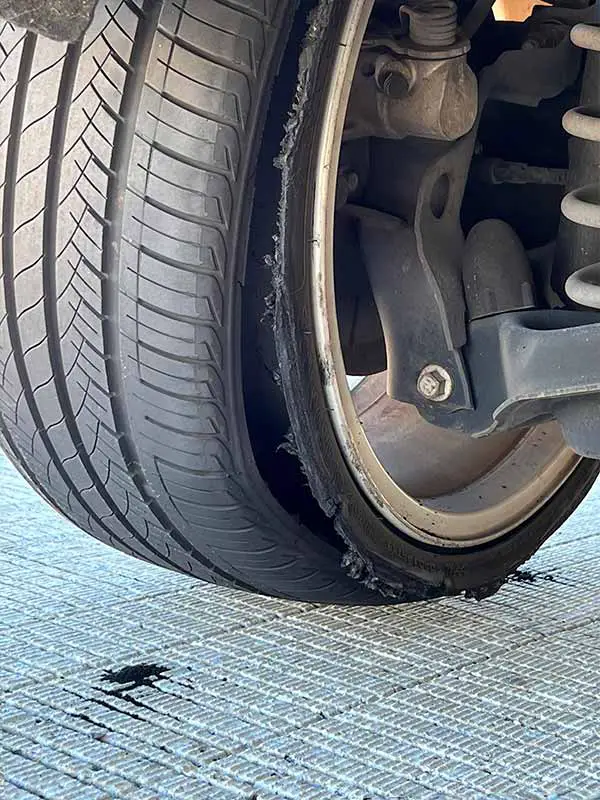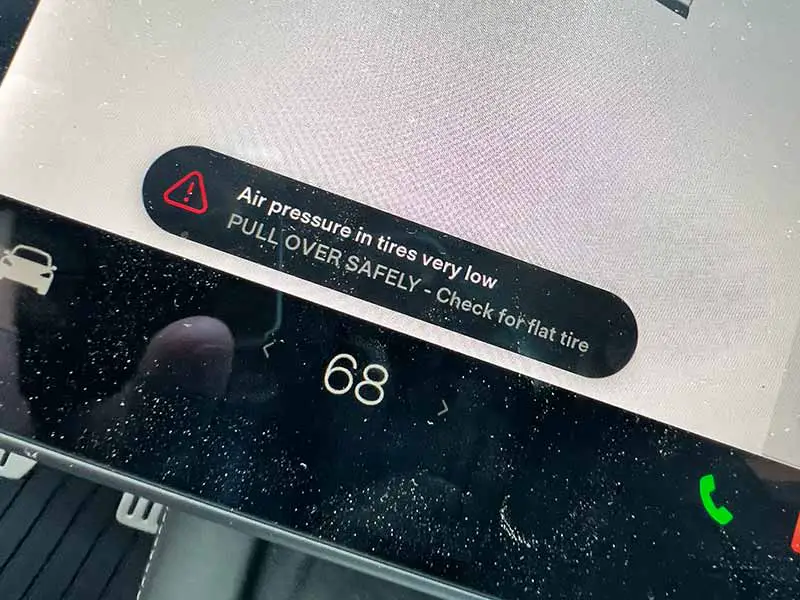Did you know that a simple tire check could be the difference between a safe journey and a life-altering accident? Tires are the unsung heroes of road safety, and neglecting them could put you and your loved ones at risk.
Tire-Related Accidents Statistics
According to a sample study by the National Motor Vehicle Crash Causation Survey, 9% of the examined car crashes involved a vehicle with pre-crash tire problems. This reflects 2,188,970 crashes from a national perspective and highlights the significance of tire-related issues in vehicle accidents.
In this article, we delve into the annual statistics of tire-related accidents, explore the common causes, and offer expert advice on preventive measures. We also discuss the importance of tire monitoring systems and provide actionable tire safety tips to help you stay safe on the road.
Let’s take a closer look.

The Big Picture: Overall Statistics
When it comes to vehicle safety, tires play a crucial role that often goes unnoticed until something goes wrong. According to various studies and reports, tire-related issues contribute to a significant number of road accidents each year.
Percentage of Accidents Caused by Tires
One of the most pressing questions people have is, “What percentage of accidents are caused by tires?” To answer this, let’s look at some numbers:
The National Motor Vehicle Crash Causation Survey found that 9% of the car crashes they examined involved a vehicle with pre-crash tire problems. This data reflects 2,188,970 crashes from a national perspective.
While 9% might seem like a small number, it’s important to remember that this translates to hundreds of thousands of accidents and injuries, some of which are fatal.
Types of Tire-Related Accidents
Understanding the types of tire-related accidents can give us a clearer picture of the risks involved. Here are the most common types:
- Tire Blowouts: A sudden loss of air pressure leading to a catastrophic failure of the tire.
- Tread Separation: The outermost layer of the tire peeling away, often at high speeds.
- Flat Tires: Slow or rapid deflation that affects the vehicle’s control.
- Underinflated Tires: Tires with insufficient air pressure, leading to poor vehicle handling.
Factors Contributing to Tire-Related Accidents
It’s not just the condition of the tires that contribute to accidents; several other factors play a role:
- Road Conditions: Poorly maintained roads can exacerbate tire wear and tear.
- Weather: Wet or icy conditions can make tires lose grip.
- Vehicle Load: Overloading your vehicle can put extra stress on the tires.
- Driving Behavior: Aggressive driving, like sharp turns and rapid acceleration, can also affect tire integrity.

Common Causes of Tire-Related Accidents
Understanding the root causes of tire-related accidents is essential for prevention. While tires are built to be durable and safe, various factors can compromise their integrity, leading to dangerous situations on the road.
The Role of Tire Blowouts
Tire blowouts are one of the most dramatic and dangerous types of tire failures. A blowout is a sudden and rapid loss of air pressure, often accompanied by a loud bang. This can happen for several reasons:
- Age of the Tire: Older tires are more susceptible to blowouts.
- Overloading: Exceeding the tire’s load capacity can cause it to burst.
- High Speeds: Driving at high speeds can generate heat, weakening the tire.
Tread Separation and Its Dangers
Another common cause of tire-related accidents is tread separation. This occurs when the outer layer of the tire, known as the tread, separates from the rest of the tire. This is particularly dangerous because:
- Loss of Control: Tread separation often leads to a sudden loss of vehicle control.
- High-Speed Risks: This type of failure is especially hazardous at high speeds.
The Issue of Flat Tires
A flat tire is generally less dramatic than tire blowout but can be just as dangerous if it occurs while driving. Causes include:
- Punctures: Sharp objects on the road can puncture the tire.
- Wear and Tear: Over time, the tire material can weaken, leading to a flat.
Underinflated Tires: A Silent Risk
Tires that are not inflated to the correct pressure are a significant risk factor for accidents. Underinflated tires can:
- Affect Steering: The vehicle becomes harder to control.
- Increase Fuel Consumption: Lower pressure means higher rolling resistance, which in turn means more fuel consumption.
- Cause Overheating: Lower pressure can cause the tire to overheat, increasing the risk of a blowout.
Other Contributing Factors
While the condition of the tire is often the primary cause, external factors can also contribute to tire-related accidents:
- Road Conditions: Potholes, debris, and uneven road surfaces can damage tires.
- Weather Conditions: Rain, snow, and ice can make it challenging for even well-maintained tires to grip the road.
- Driver Behavior: Speeding, sharp turns, and hard braking can all put extra stress on tires.

The #1 Culprit: Main Cause of Tire Problems
While there are various factors that contribute to tire-related accidents, one stands out as the most prevalent: incorrect tire pressure. Understanding why this is the main cause can help drivers take preventive measures.
The Science Behind Tire Pressure
Tire pressure is the amount of air inside the tire, usually measured in pounds per square inch (PSI). The right amount of pressure ensures that the tire maintains optimal contact with the road, providing better control and efficiency. Here’s why incorrect tire pressure is so problematic:
- Underinflated Tires: When tires don’t have enough air, they can’t maintain their shape, making the vehicle harder to control.
- Overinflated Tires: Too much air makes the tire stiff and can reduce the tire’s contact with the road, leading to a harsher ride and less grip.
Consequences of Incorrect Tire Pressure
The repercussions of not maintaining the correct tire pressure are far-reaching:
- Reduced Fuel Efficiency: Incorrect pressure can increase rolling resistance, leading to higher fuel consumption.
- Premature Wear: Both overinflated and underinflated tires wear out more quickly.
- Increased Risk of Blowouts: Incorrect pressure can lead to overheating and, ultimately, a blowout.
How Often Is Incorrect Pressure the Cause?
Studies have shown that incorrect tire pressure is a leading factor in many tire-related accidents. For example:
- The Rubber Manufacturers Association found that only 19% of drivers properly check and inflate their tires.
- According to the NHTSA, underinflated tires triple the risk of a crash.
Monitoring and Maintenance
The good news is that incorrect tire pressure is one of the easiest problems to fix:
- Regular Checks: A simple tire gauge can be used to check tire pressure regularly.
- Use a Tire Pressure Monitoring System: Many modern vehicles come equipped with a system that alerts the driver if tire pressure drops below a certain level.

The Role of Tire Blowouts
A tire blowout is a sudden and dramatic event where a tire rapidly loses all its air pressure, often with a loud bang. While blowouts account for a smaller percentage of all tire-related accidents, their sudden nature makes them particularly dangerous.
Frequency of Blowouts Leading to Accidents
One question that often arises is, “How often do tire blowouts cause accidents?” While the exact frequency can vary based on several factors, such as road conditions and vehicle type, it’s important to note:
- The NHTSA estimates that tire blowouts contribute to around 400 fatalities and 10,000 injuries in the U.S. each year.
- Blowouts are more common in the summer months due to higher temperatures affecting tire pressure and condition.
Causes of Tire Blowouts
Understanding the causes of tire blowouts can help in prevention. Common causes include:
- Overloading: Carrying weight beyond the tire’s load capacity.
- Punctures: Sharp objects on the road can cause a sudden loss of air.
- Heat: High temperatures can cause the air inside the tire to expand, increasing internal pressure.
- Wear and Tear: Old or worn-out tires are more susceptible to blowouts.
Impact on Steering and Control
A tire blowout can have a significant impact on the vehicle’s steering and control:
- Immediate Loss of Control: The vehicle may swerve unpredictably.
- Steering Wheel Vibration: The steering wheel may start to shake or become difficult to turn.
- Difficulty in Braking: Stopping the vehicle safely becomes more challenging.
Preventive Measures
While tire blowouts can be alarming, there are steps you can take to minimize the risks:
- Regular Inspection: Check for signs of wear, damage, or objects embedded in the tire.
- Maintain Correct Pressure: Use a tire gauge to ensure your tires are inflated to the manufacturer’s recommended levels.
- Avoid Overloading: Be mindful of your vehicle’s load capacity, especially when traveling with heavy luggage or towing.
When Are Tires Unsafe?
Knowing when tires are unsafe is crucial for preventing accidents. Tires may look simple, but they are complex pieces of engineering designed to provide grip, support load, and absorb shocks. When they fail, the consequences can be severe.
Tread Depth: The First Indicator
One of the most straightforward ways to determine if a tire is unsafe is by checking the tread depth. Tread depth is crucial for providing grip, especially in wet conditions. Here’s how to check it:
- The Penny Test: Insert a penny into the tread with Lincoln’s head facing down. If you can see all of Lincoln’s head, it’s time to replace the tire.
- Tread Wear Indicators: Modern tires have built-in indicators that become visible as the tire wears down.
Monitoring Systems: Your Digital Guardian
Tire Pressure Monitoring Systems (TPMS) are invaluable tools for assessing tire safety. These systems alert you when tire pressure is too low, allowing you to take corrective action before a serious issue arises.
Visual and Physical Checks
Apart from tread depth and TPMS, other visual and physical checks can indicate an unsafe tire:
- Sidewall Cracks: Cracks in the sidewall are a sign of aging or damage.
- Bulges and Blisters: These indicate weak spots that could lead to a blowout.
- Vibration: Unusual vibrations while driving can signal internal tire damage.
The Role of Tire Age
Tires have a shelf life, usually around six years, regardless of tread depth. Rubber compounds break down over time, making older tires more susceptible to failure.
At What Point Are Tires Unsafe?
To answer the question, “At what point are tires unsafe?” consider the following:
- Tread Depth Below 2/32 inch: This is the legal minimum in most jurisdictions.
- Persistent Low Pressure Alerts: If your TPMS is consistently warning you, it’s time for a check-up.
- Visible Damage: Any cracks, bulges, or unusual wear patterns should be immediate red flags.

Monitoring Systems and Their Importance
Tire Pressure Monitoring Systems (TPMS) have become an integral part of modern vehicles, designed to alert drivers when tire pressure falls below a safe level. Their role in preventing tire-related accidents cannot be overstated.
How TPMS Works
Understanding how TPMS works can help you make the most of this safety feature:
- Direct Systems: These use sensors inside each tire to measure air pressure and send the data to the vehicle’s computer.
- Indirect Systems: These use wheel speed sensors to estimate tire pressure based on how fast the tires are rotating.
Why TPMS Is Crucial
The importance of TPMS in vehicle safety is highlighted by several key benefits:
- Early Warning: TPMS provides an early warning, often before the driver can notice a difference in driving performance.
- Preventing Blowouts: By alerting the driver to low pressure, TPMS can help prevent blowouts caused by underinflation.
- Fuel Efficiency: Proper tire pressure helps maintain fuel efficiency, and TPMS ensures you’re always in the optimal range.
Limitations of TPMS
While TPMS is a valuable tool, it’s essential to be aware of its limitations:
- Not a Replacement for Manual Checks: TPMS is a supplementary safety measure and should not replace regular manual checks.
- Calibration Issues: Sometimes, TPMS needs to be recalibrated, especially after tire rotation or replacement.
How to Use TPMS Effectively
To make the most of your TPMS, consider the following tips:
- Regular Checks: Even with TPMS, perform manual checks at least once a month.
- Calibration: Ensure your TPMS is calibrated correctly, especially after any tire service.
- Heed Warnings: Never ignore a TPMS alert. Check your tire pressure as soon as it’s safe to do so.

Tire Maintenance: A Preventive Measure
Tire maintenance is often overlooked, but it’s a critical aspect of vehicle safety. Regular maintenance not only extends the lifespan of your tires but also significantly reduces the risk of tire-related accidents.
Key Aspects of Tire Maintenance
Understanding the key aspects of tire maintenance can help you keep your tires in top condition:
- Pressure Checks: Regularly check the tire pressure using a tire gauge, even if you have TPMS.
- Rotation: Tires should be rotated every 6,000 to 8,000 miles to ensure even wear.
- Alignment: Misaligned tires can cause uneven wear and affect vehicle handling.
- Balancing: Unbalanced tires can lead to vibrations and premature wear.
Tire Safety Tips
Here are some practical tips for maintaining your tires:
- Check Pressure in the Morning: Tire pressure is most accurate when the tires are cold.
- Inspect for Foreign Objects: Regularly check the surface for nails, stones, or other objects that could puncture the tire.
- Look for Wear Patterns: Uneven wear could indicate alignment issues or the need for rotation.
Tools for Maintenance
Having the right tools can make tire maintenance much easier:
- Tire Gauge: A simple but essential tool for checking pressure.
- Tread Depth Gauge: More accurate than the penny test for checking tread depth.
- Torque Wrench: For ensuring lug nuts are tightened to the correct specifications.
The Role of Professional Inspections
While DIY maintenance is crucial, professional inspections offer additional benefits:
- Expert Assessment: Professionals can spot issues that you might miss.
- Advanced Tools: They have equipment for more accurate assessments, like computerized alignment systems.
- Repairs and Replacements: Professionals can quickly repair or replace damaged tires.
Resources
Below are some links you may find helpful when learning about tires
- Tire safety ratings and awareness | Tire wise – National Highway Traffic Safety Administration
- Special investigation report: Selected issues in passenger vehicle tire safety – National Transportation Safety Board
Final Thoughts
From the alarming statistics to the common causes like incorrect tire pressure and blowouts, it’s evident that a significant number of tire-related accidents can be avoided with proper care and maintenance.
Tools like Tire Pressure Monitoring Systems (TPMS) and regular professional inspections can serve as additional safety nets. By taking these preventive steps, you not only extend the life of your tires but also contribute to safer roads for everyone.
Good luck and happy motoring.





